
None
| Author: | Moukhsil and Daoudene, 2019 |
| Age: | Mesoproterozoic |
| Reference section: | Reference outcrops 18-AM-220 located ~1.5 km north of Mulot Lake (north of NTS sheet 32A02) and 18-AM-221 located 560 m NW of Renard Lake (south of sheet 32A07) |
| Type area: | Marianne Lake area (NTS sheet 32A02) |
| Geological province: | Grenville Province |
| Geological subdivision: | Allochton |
| Lithology: | Felsic, intermediate and mafic intrusive rocks |
| Type: | Lithodemic |
| Rank: | Suite |
| Status: | Formal |
| Use: | Active |
None
Background
The Marianne Plutonic Suite was defined by Moukhsil and Daoudene (2019) during mapping of the Commissaires Lake area in the Saguenay–Lac-Saint-Jean region (NTS sheets 32A02 and 32A07).
Description
The Marianne Plutonic Suite consists mainly of a large polyphase batholith consisting of mangerite, orthopyroxene syenite, gabbronorite, migmatitized gabbronorite, quartz monzodiorite and minor amounts of alkaline feldspar alkaline granite, jotunite, hypersthene diorite, charnockite and granitic gneiss. The Marianne Plutonic Suite hosts enclaves or decametre to kilometre-scale klippes of metasedimentary rocks attributed to the Wabash Complex. The different facies of the suite are scattered in the intrusion and cannot be grouped into separate units at the 1:50 000 scale. This suite is very magnetic and is easy to delineate from aeromagnetic maps (Intissar and Benahmed, 2015). The interpretation of these maps, coupled with the trajectory of the main planar fabric, suggests that the Marianne Plutonic Suite underwent several folding phases.
 Mangerite is whitish in altered patina, greenish in fresh exposure, magnetic, fine, medium or coarse grained and also porphyritic. Phenocrystals of K-feldspar (locally perthitic) and plagioclase variably altered to white mica can represent up to 30% of the rock; they are on average 1 to 4 cm long. Mangerite contains 4 to 20% quartz in large crystals (1-2 cm) with undulatory extinction. Mangerite also contains large orthopyroxene crystals associated with amphibole and clinopyroxene. When concentrated in clusters, these ferromagnesian minerals are associated with opaque minerals, including magnetite. Accessory minerals observed in thin section are apatite, epidote and zircon. Generally, mangerite is massive; in places, it is affected by a foliation that is more visible in the medium to fine-grained facies (e.g., outcrop 18-YD-2166). This facies contains more amphibole than porphyritic facies and orthopyroxene is generally more altered to iddingsite.
Mangerite is whitish in altered patina, greenish in fresh exposure, magnetic, fine, medium or coarse grained and also porphyritic. Phenocrystals of K-feldspar (locally perthitic) and plagioclase variably altered to white mica can represent up to 30% of the rock; they are on average 1 to 4 cm long. Mangerite contains 4 to 20% quartz in large crystals (1-2 cm) with undulatory extinction. Mangerite also contains large orthopyroxene crystals associated with amphibole and clinopyroxene. When concentrated in clusters, these ferromagnesian minerals are associated with opaque minerals, including magnetite. Accessory minerals observed in thin section are apatite, epidote and zircon. Generally, mangerite is massive; in places, it is affected by a foliation that is more visible in the medium to fine-grained facies (e.g., outcrop 18-YD-2166). This facies contains more amphibole than porphyritic facies and orthopyroxene is generally more altered to iddingsite.
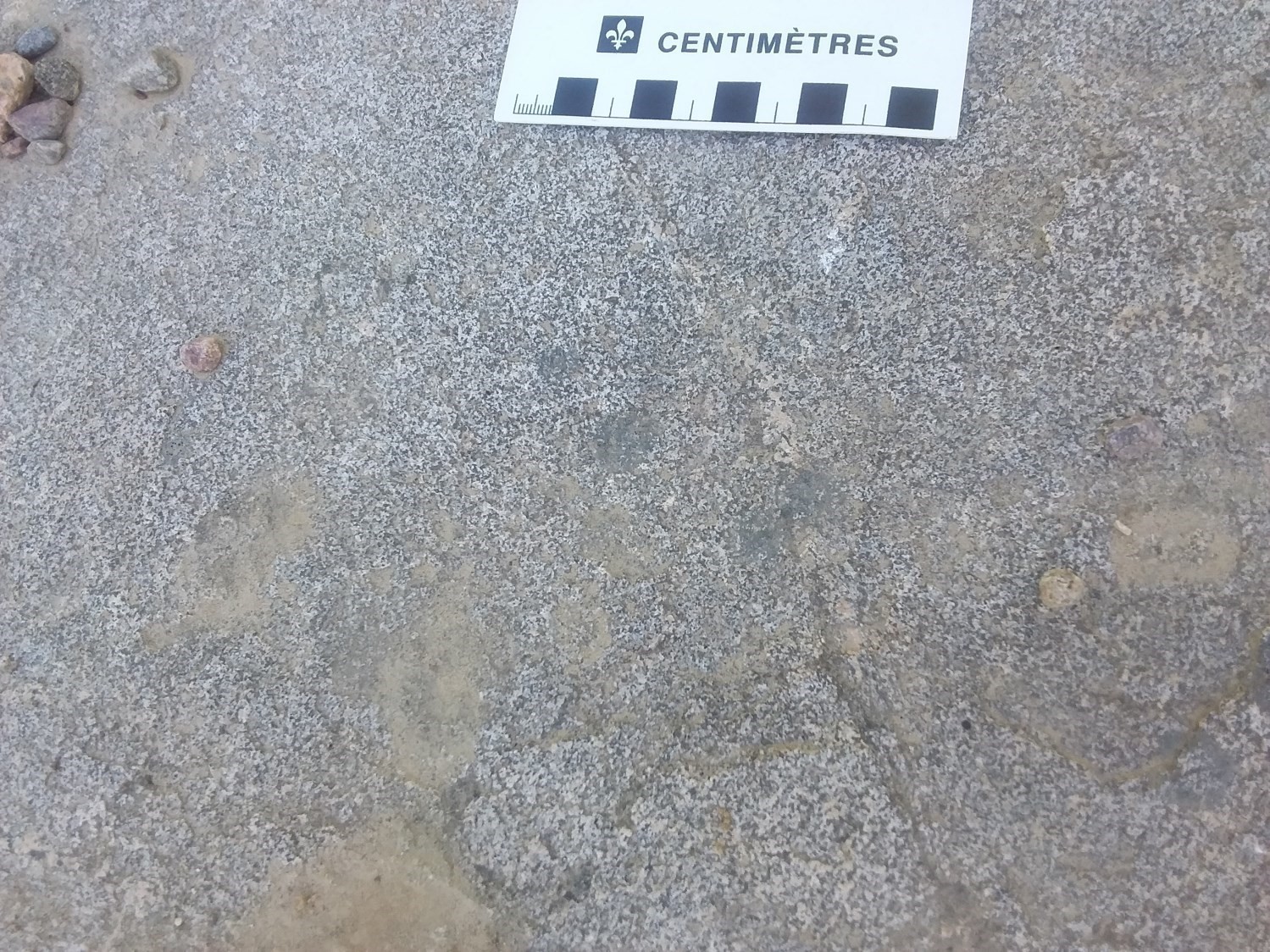
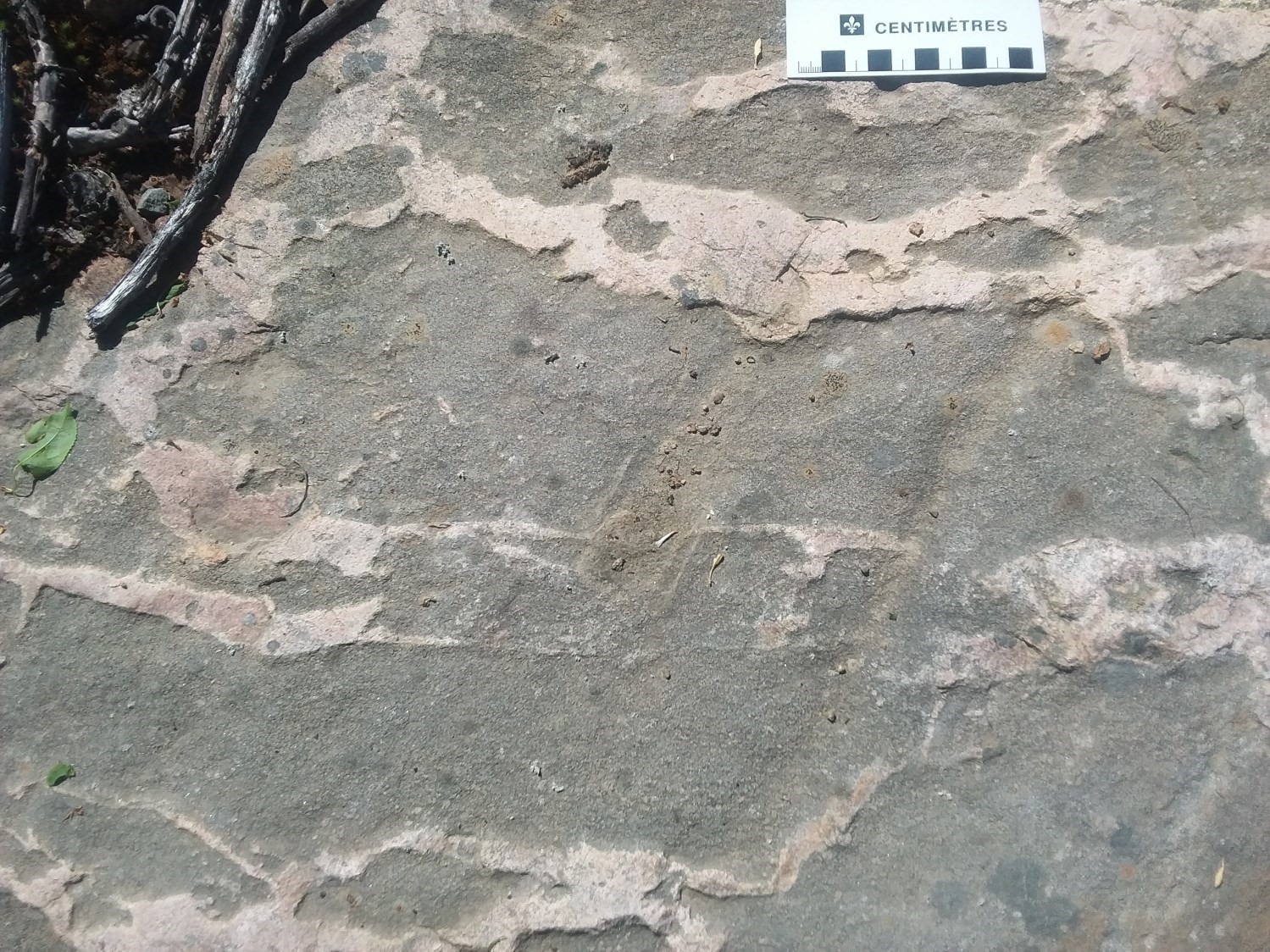 Based on the fresh surface colour, two syenite facies are mapped in the Marianne Plutonic Suite. One is pink in fresh exposure while the other is grey. Since the two facies are comagmatic and cogenetic, they are too closely interdigitized on a small scale and therefore cannot be separated by map. In fact, enclaves or intrusions of one facies are visible in the other. Grey syenite is fine grained, locally K-feldspar porphyritic. It is biotite rich (10-15%) and contains about 2% large orthopyroxene crystals (<1 cm) and 5-10% clinopyroxene. K-feldspar (40%) is perthitic, plagioclase (15%) is less altered and contains biotite flakes, while quartz (2-5%) occurs in large zones with weak undulatory extinction. Apatite, zircon and carbonates are accessory mineral phases (<3%).
Based on the fresh surface colour, two syenite facies are mapped in the Marianne Plutonic Suite. One is pink in fresh exposure while the other is grey. Since the two facies are comagmatic and cogenetic, they are too closely interdigitized on a small scale and therefore cannot be separated by map. In fact, enclaves or intrusions of one facies are visible in the other. Grey syenite is fine grained, locally K-feldspar porphyritic. It is biotite rich (10-15%) and contains about 2% large orthopyroxene crystals (<1 cm) and 5-10% clinopyroxene. K-feldspar (40%) is perthitic, plagioclase (15%) is less altered and contains biotite flakes, while quartz (2-5%) occurs in large zones with weak undulatory extinction. Apatite, zircon and carbonates are accessory mineral phases (<3%).
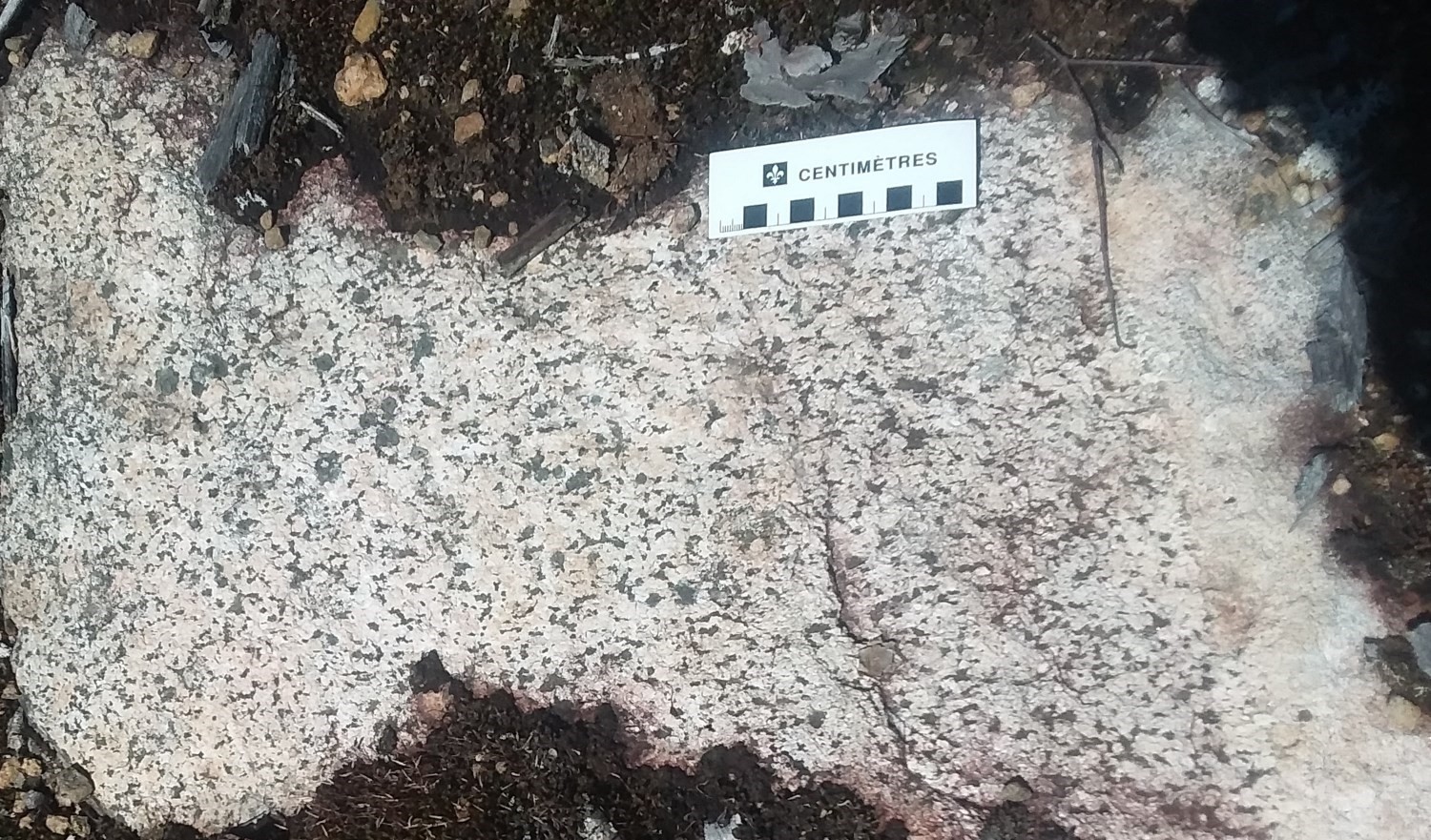 Pink syenite is coarse grained, locally perthitic K-feldspar (microcline) porphyritic and foliated. It has the same mineralogy as the grey facies but contains more orthopyroxene (4%) and K-feldspar (45%) and less biotite (<5%). The rock contains hornblende (<10%), epidote in large euhedral crystals (<1%) and opaque minerals (pyrite, pyrrhotite, magnetite). In thin section, amphibole cores contain light green orthopyroxene. Apatite rods are disseminated throughout the pink syenite matrix.
Pink syenite is coarse grained, locally perthitic K-feldspar (microcline) porphyritic and foliated. It has the same mineralogy as the grey facies but contains more orthopyroxene (4%) and K-feldspar (45%) and less biotite (<5%). The rock contains hornblende (<10%), epidote in large euhedral crystals (<1%) and opaque minerals (pyrite, pyrrhotite, magnetite). In thin section, amphibole cores contain light green orthopyroxene. Apatite rods are disseminated throughout the pink syenite matrix.
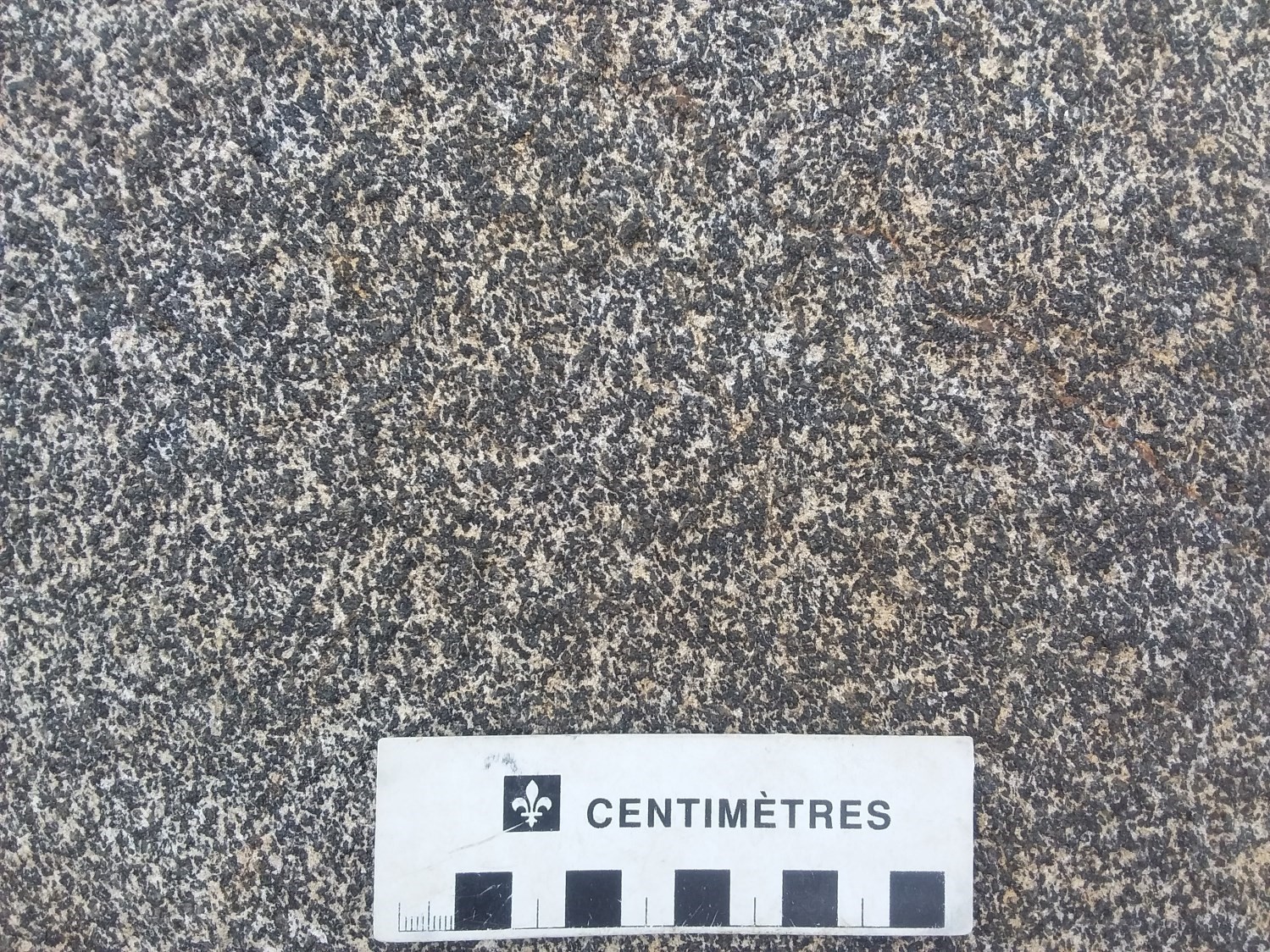 Gabbronorite is grey-black in altered patina and greenish black in fresh exposure. It is medium to coarse grained, homogeneous, heterogranular, locally massive and ophitic to subophitic. In thin section, orthopyroxene forms small euhedral crystals, while clinopyroxene occurs in clusters of small millimetric grains arranged between plagioclase rods. These ferromagnesian minerals are associated with small reddish biotite flakes (<1%). Opaque minerals and apatite are regularly observed in gabbronorite. The latter is locally migmatitized to varying degrees and the tonalitic mobilisate is conformable and/or unconformable to rock foliation. Migmatitic gabbronorite is medium grained, grey-green in altered patina and black-green in fresh exposure. Plagioclase occurs in grains altered to white mica and amphibole forms large greenish crystals. Migmatitic gabbronorite contains hemo-ilmenite and apatite.
Gabbronorite is grey-black in altered patina and greenish black in fresh exposure. It is medium to coarse grained, homogeneous, heterogranular, locally massive and ophitic to subophitic. In thin section, orthopyroxene forms small euhedral crystals, while clinopyroxene occurs in clusters of small millimetric grains arranged between plagioclase rods. These ferromagnesian minerals are associated with small reddish biotite flakes (<1%). Opaque minerals and apatite are regularly observed in gabbronorite. The latter is locally migmatitized to varying degrees and the tonalitic mobilisate is conformable and/or unconformable to rock foliation. Migmatitic gabbronorite is medium grained, grey-green in altered patina and black-green in fresh exposure. Plagioclase occurs in grains altered to white mica and amphibole forms large greenish crystals. Migmatitic gabbronorite contains hemo-ilmenite and apatite.
 Quartz monzodiorite is greyish in altered patina and grey-green in fresh exposure. It is generally medium grained and contains millimetric to centimetric fine-grained diorite enclaves. Monzodiorite is composed of quartz with weak undulatory extinction (8-18%), plagioclase with fractures filled with white mica, ferromagnesian minerals (orthopyroxene, clinopyroxene, green hornblende, biotite) whose occurrence in elongated clusters highlights foliation, as well as accessory minerals such as apatite, zircon and epidote. In thin section, orthopyroxene grains are rimed by green hornblende and altered to a yellowish to reddish mineral (iddingsite).
Quartz monzodiorite is greyish in altered patina and grey-green in fresh exposure. It is generally medium grained and contains millimetric to centimetric fine-grained diorite enclaves. Monzodiorite is composed of quartz with weak undulatory extinction (8-18%), plagioclase with fractures filled with white mica, ferromagnesian minerals (orthopyroxene, clinopyroxene, green hornblende, biotite) whose occurrence in elongated clusters highlights foliation, as well as accessory minerals such as apatite, zircon and epidote. In thin section, orthopyroxene grains are rimed by green hornblende and altered to a yellowish to reddish mineral (iddingsite).
Jotunite (hypersthene monzodiorite) is very similar to quartz monzodiorite, except that the former contains 7% hypersthene. Jotunite is beige-pink in altered patina and salmon pink in fresh exposure. It contains K-feldspar, plagioclase, biotite and hornblende.
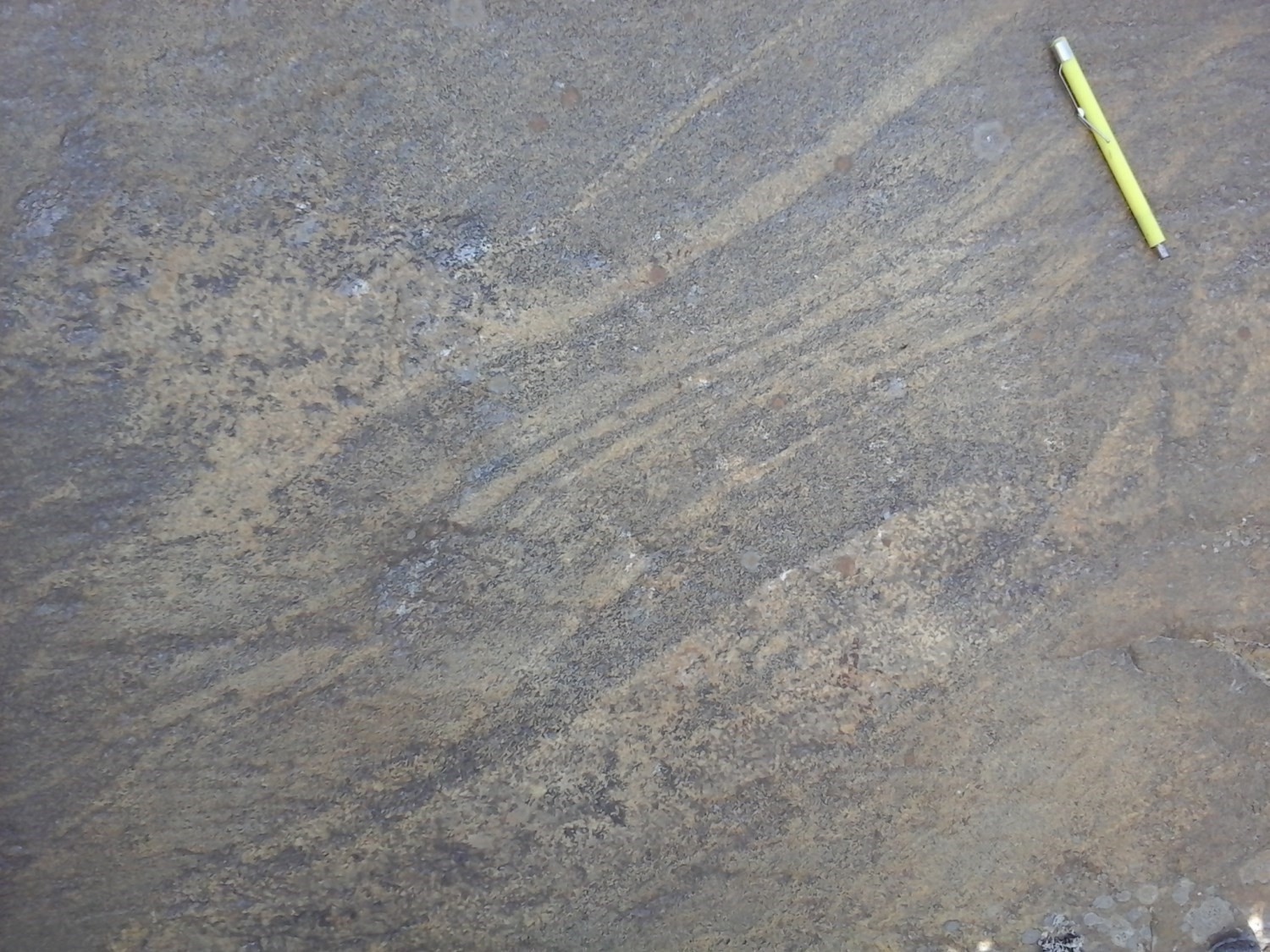 Hypersthene diorite is brown-black in altered patina and grey-black in fresh exposure. It is fine to medium grained, foliated and locally migmatitic with tonalitic mobilisate. It is composed of plagioclase, orthopyroxene, clinopyroxene, biotite, opaque minerals and accessory apatite.
Hypersthene diorite is brown-black in altered patina and grey-black in fresh exposure. It is fine to medium grained, foliated and locally migmatitic with tonalitic mobilisate. It is composed of plagioclase, orthopyroxene, clinopyroxene, biotite, opaque minerals and accessory apatite.
 Alkaline feldspar granite is pink-brown in altered patina and pinkish in fresh exposure. It is coarse grained, locally perthitic K-feldspar porphyritic (40%). Alkaline feldspar granite is composed of 25-35% quartz, ~10% plagioclase, 3% orthopyroxene altered to iddingsite, 3% biotite and 2-4% green hornblende. In the field, the mineralogical composition of granite easily evolves to that of mangerite from one outcrop to another due to relative variations in quartz and feldspar. Granite also contains myrmekite and accessory mineral phases, including opaque minerals, apatite, epidote and zircon.
Alkaline feldspar granite is pink-brown in altered patina and pinkish in fresh exposure. It is coarse grained, locally perthitic K-feldspar porphyritic (40%). Alkaline feldspar granite is composed of 25-35% quartz, ~10% plagioclase, 3% orthopyroxene altered to iddingsite, 3% biotite and 2-4% green hornblende. In the field, the mineralogical composition of granite easily evolves to that of mangerite from one outcrop to another due to relative variations in quartz and feldspar. Granite also contains myrmekite and accessory mineral phases, including opaque minerals, apatite, epidote and zircon.
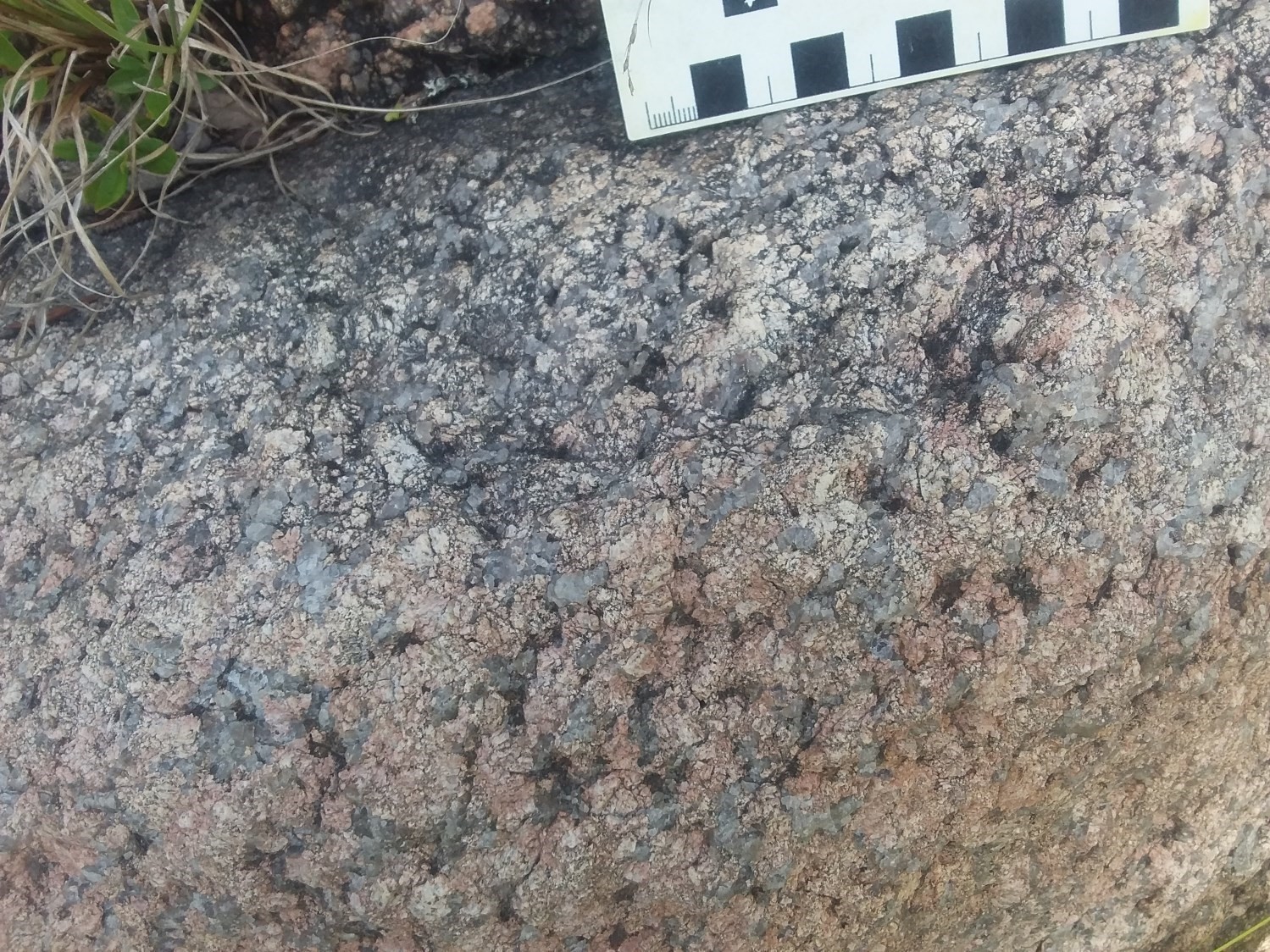 Charnockite is pink-brown in altered patina and pink-grey in fresh exposure. It is medium to coarse grained, homogeneous, heterogranular and foliated. It contains about 30% perthitic K-feldspar, 25% plagioclase strongly altered in white mica and 30-35% quartz in large zones with weak undulatory extinction. Ferromagnesian minerals are orthopyroxene (1%), green hornblende (1%) and biotite (3%). Myrmekite and secondary mineral phases, including apatite, epidote, zircon and opaque minerals (magnetite), account for 3% of the rock. Trace carbonate is associated with hornblende.
Charnockite is pink-brown in altered patina and pink-grey in fresh exposure. It is medium to coarse grained, homogeneous, heterogranular and foliated. It contains about 30% perthitic K-feldspar, 25% plagioclase strongly altered in white mica and 30-35% quartz in large zones with weak undulatory extinction. Ferromagnesian minerals are orthopyroxene (1%), green hornblende (1%) and biotite (3%). Myrmekite and secondary mineral phases, including apatite, epidote, zircon and opaque minerals (magnetite), account for 3% of the rock. Trace carbonate is associated with hornblende.
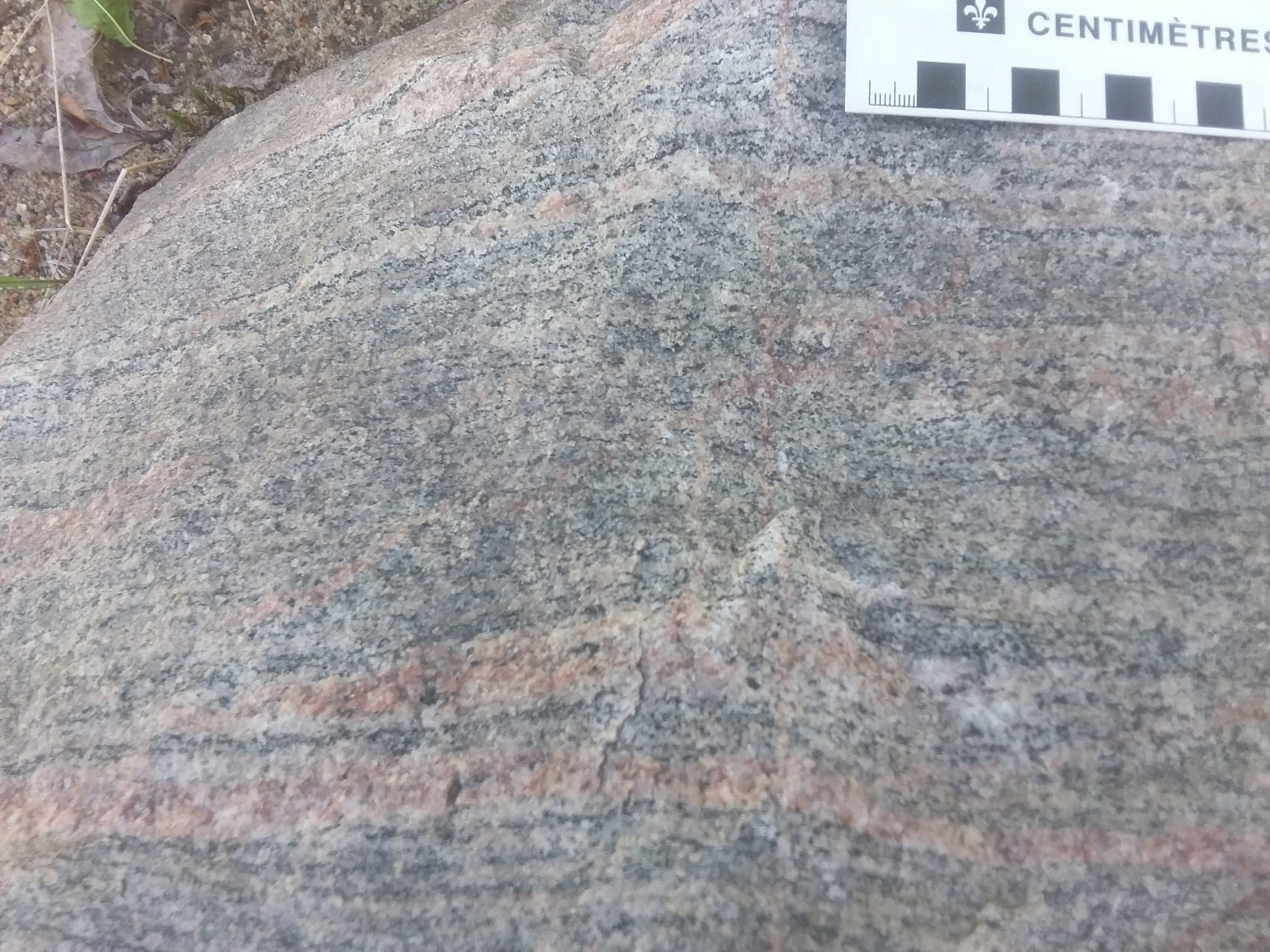 Granitic gneiss is grey-pink in fresh and altered surfaces. It is marked by banding that results in alternating grey and pink bands, respectively rich in ferromagnesian minerals (biotite and hornblende) and K-feldspar. It seems difficult to attribute an origin to this granitic gneiss. However, it could be a metasedimentary facies intruded by granitic dykes, all of which have been highly transposed following one or more phases of intense deformation. In fact, several decametric to kilometric enclaves or klippes of metasedimentary rocks assigned to the Wabash Complex or Barrois Complex are observed in the suite.
Granitic gneiss is grey-pink in fresh and altered surfaces. It is marked by banding that results in alternating grey and pink bands, respectively rich in ferromagnesian minerals (biotite and hornblende) and K-feldspar. It seems difficult to attribute an origin to this granitic gneiss. However, it could be a metasedimentary facies intruded by granitic dykes, all of which have been highly transposed following one or more phases of intense deformation. In fact, several decametric to kilometric enclaves or klippes of metasedimentary rocks assigned to the Wabash Complex or Barrois Complex are observed in the suite.
Thickness and Distribution
The Marianne Plutonic Suite outcrops in sheets 32A02 and 32A07. On the map, it mainly forms a large ovoid batholith with an area of approximately 250 km2 and a long axis oriented NW-SE. To the south of the batholith, three small lenticular intrusions ranging from 1.6 to 5 km2 are linked to the suite.
Dating
A dating on the sample 2018-AM-0221A was recently carried out.
| Unit | Sample Number | Isotopic System | Mineral | Crystallization Age (Ma) | (+) | (-) | Reference(s) |
| mPmae | 2018-AM-0221A | U-Pb | Zircon | 1021 | 18 | 18 | Papapavlou, 2019 |
Stratigraphic Relationship(s)
The Marianne Plutonic Suite intrudes to the west into the Bardeau Plutonic Suite, to the south and east into Wabash Complex paragneiss and to the north into Barrois Complex paragneiss. The northern part of the intrusion contains paragneiss klippes of the Barrois Complex, while to the south it contains several migmatitic biotite paragneiss enclaves and klippes of the Wabash Complex.
Paleontology
Does not apply.
References
Publications available through Sigéom Examin
INTISSAR, R., BENAHMED, S. 2015. LEVE MAGNETIQUE AEROPORTE DANS LE SECTEUR OUEST DU LAC-ST-JEAN, PROVINCE DE GRENVILLE. MERN, GOLDAK AIRBORNE SURVEYS. DP 2015-06, 7 pages and 2 plans.
MOUKHSIL, A., DAOUDENE, Y. 2019. Géologie de la région du lac des Commissaires, Province de Grenville, région du Saguenay–Lac-Saint-Jean, Québec, Canada. MERN. BG 2019-01.
PAPAPAVLOU, K. 2019. U-Pb geochronology report, Grenville 2018-2019. UQAM. MB 2019-11, 21 pages.

